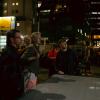Tour of Japan 2025: day 1

Imagine this: you get to join the Rotterdam Philharmonic Orchestra on tour in Japan. You’ve never been to Japan, let alone with an orchestra! What would that be like? What would you experience? In this blog I can’t tell you how it would be for you, I can only speak for myself.
On Wednesday morning, with a suitcase in one hand and a flutter of nerves in my stomach, I arrived at De Doelen. At 1:00 p.m. the bus to Schiphol was set to depart. I quickly ran up to the office to say goodbye to my colleagues. They sent me off with travel tips, flight tips, and lots of good-luck wishes. Then it was time to head downstairs and join the musicians. The bus slowly filled, and after some parting words from managing director Piet van Gennip and artistic planner Arthur van der Drift, we were ready to go. Our colleagues waved us off, and for a moment I felt as if I were heading off on a school trip.
The bus quickly filled with cheerful chatter. “You did bring your passport, right?” someone joked, while behind me another voice was sharing tips about our destination. At the Blijdorp stop a few more musicians climbed aboard, among them Juliette Hurel, our principal flutist. She spotted me and waved enthusiastically. “So great that you’re here!” she called, and I immediately felt welcome. Not five minutes later, academy musician Simon Dallmeier offered me my first piece of candy. Nerves made me politely decline his next three attempts.
Once at Schiphol we headed for the check-in desk. On the way, I was handed an RPhO sticker for my suitcase. Following the instructions of violinist Giulio Greci, I stuck it on completely crooked. He looked at my handiwork with mock dismay: “I am so sorry. I really thought you got it, but it’s a bit crooked.”
After the usual airport rituals—check-in, security, gate—I struck up a conversation with double bassist Jonathan Focquaert. This would be his third trip to Japan with the orchestra. He told me about a previous tour when the Japanese summer heat caused varnish on several instruments to melt. When the musicians opened their cases, there was genuine doubt whether the instruments would even survive tuning.
In the air I glanced around at my new colleagues, the people I’d be traveling with for the next two weeks. Although I’d been working for the orchestra for several months already, I certainly didn’t know everyone by name. I wondered how many names I’d know by the time we returned home. Next to me, trumpeter Alex Elia settled in for the long flight. Diagonally in front of me, a colleague explored the entertainment screen, and I couldn’t help but smile when he landed on the classical music section and eagerly browsed through Mozart’s works.
After a six-hour flight it was time to transfer in Dubai. Fatigue started to creep in. The airport was crowded as we made our way to the next gate. There I met up with my colleague from the content team, Sanne Bakkes. She was handing out disposable cameras to the musicians with the request: “Would you take photos during the tour?” I was curious to see what moments they’d capture in the coming weeks.
After a short layover, it was time for the final and longest leg: to Osaka, Japan. On this flight I sat next to principal clarinetist Bruno Bonasea. We talked about cooking, music, and our flight path, but after an hour and a half my eyes began to burn. “Don’t fall asleep, or you’ll get jet lag,” he warned. But my eyelids won the battle over discipline, and I drifted off, missing the last hours of the flight.
At 5:15 p.m. local time we landed in Osaka. Over twenty hours of travel behind us. Exhaustion weighed heavy but quickly melted away with what we saw: as the bus carried us toward the hotel, the sky and bay turned gold and purple. A breathtaking sunset over Osaka Bay.

The bus filled with laughter, music, and chatter. Japanese pop played from someone’s phone speaker—“to get in the mood.” Sleepy colleagues gazed dreamily out the windows. The adventure had only just begun, and although we were all tired, there was an energy in the air. A sense of excited anticipation, as if everyone knew: this is going to be special.
When we finally arrived at the hotel, the big moment came: the truck carrying the instruments was waiting. A small group of musicians gathered around the tailgate. Few words were spoken, but their expressions said it all. Some leaned forward, intent, as if to see whether their instrument would still recognize its own voice. A flicker of anxiety crept over me, remembering my earlier conversation with Jonathan—about melted varnish and broken strings.
The tailgate opened. One by one the cases appeared. Tension gave way to relief, to recognition. Click. A bassoon. A cello. A trombone. All intact.
Suddenly jet lag was forgotten, the long journey worth it. Laughter broke out, and even a few small cheers. “We all made it,” someone said—and everyone knew exactly what that meant.
Text: Maxime de Bruin
